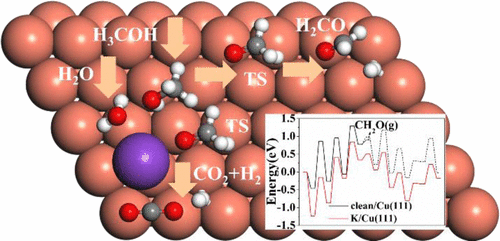当前位置:
X-MOL 学术
›
J. Phys. Chem. C
›
论文详情
Our official English website, www.x-mol.net, welcomes your feedback! (Note: you will need to create a separate account there.)
Effect of Potassium on Methanol Steam Reforming on the Cu(111) and Cu(110) Surfaces: A DFT Study
The Journal of Physical Chemistry C ( IF 3.7 ) Pub Date : 2021-09-16 , DOI: 10.1021/acs.jpcc.1c06375 Yan-Xin Wang 1 , Hai-Li Zhang 1 , Ping An 1 , Hai-Shun Wu 1 , Jian-Feng Jia 1
The Journal of Physical Chemistry C ( IF 3.7 ) Pub Date : 2021-09-16 , DOI: 10.1021/acs.jpcc.1c06375 Yan-Xin Wang 1 , Hai-Li Zhang 1 , Ping An 1 , Hai-Shun Wu 1 , Jian-Feng Jia 1
Affiliation

|
The potassium (K) additive is of great importance in improving the efficiency of catalytic reactions in numerous industrial reaction processes. In this work, density functional theory calculations are carried out to investigate the reaction mechanism as well as selectivity and activity of the methanol steam reforming (MSR) reaction on pure and K-added Cu(111) and Cu(110) surfaces. Our results suggest that the K adatom can improve the selectivity of MSR toward CO2 by stabilizing the weakly adsorbed H2CO species and enabling it to react with OH to yield H2COOH followed by continuous dehydrogenation into CO2 and activity of MSR by favoring the rate-limiting steps for H3CO, H2O, and H3COH dehydrogenation. It is found that there are two key factors contributing to K promotion effects: one is the direct K–O bonding interaction that would stabilize nearly all oxygenates including H2CO species and the stabilized oxygenates of transition states (TSs) result in the lower dissociation barriers of key steps on both Cu surfaces; the other is the indirect interaction between K and adsorbates mediated by added surface electrons donated by K, which would affect the magnitude of interaction energies between two fragments of TSs and thus energy barriers of key steps. The fact that more electrons are donated from K to Cu(111) than to the Cu(110) surface and further to the TS complexes would result in the stronger promotion effect of K on the MSR reaction over Cu(111) compared with Cu(110). Our results emphasize the essence of the promotion effect of alkali additives on complex reaction systems.
中文翻译:

钾对 Cu(111) 和 Cu(110) 表面甲醇蒸汽重整的影响:DFT 研究
钾 (K) 添加剂在提高众多工业反应过程中的催化反应效率方面具有重要意义。在这项工作中,进行了密度泛函理论计算,以研究甲醇蒸汽重整 (MSR) 反应在纯和添加 K 的 Cu(111) 和 Cu(110) 表面上的反应机理以及选择性和活性。我们的结果表明,K 吸附原子可以通过稳定弱吸附的 H 2 CO 物质并使其与 OH 反应生成 H 2 COOH,然后连续脱氢成 CO 2和 MSR 的活性,从而提高 MSR 对 CO 2的选择性。H 3 CO、H 2 O 和 H的限速步骤3 COH脱氢。发现有两个关键因素有助于 K 促进效果:一个是直接的 K-O 键合相互作用,它可以稳定几乎所有的含氧化合物,包括 H 2CO 物种和稳定的过渡态含氧物 (TS) 导致两个铜表面上关键步骤的解离势垒较低;另一种是K与吸附质之间的间接相互作用,由K提供的附加表面电子介导,这将影响TSs的两个片段之间的相互作用能的大小,从而影响关键步骤的能垒。与 Cu(111) 相比,更多的电子从 K 提供给 Cu(111) 比 Cu(110) 表面并进一步提供给 TS 配合物的事实将导致 K 对 Cu(111) 上的 MSR 反应更强的促进作用( 110)。我们的研究结果强调了碱添加剂对复杂反应体系的促进作用的本质。
更新日期:2021-09-30
中文翻译:

钾对 Cu(111) 和 Cu(110) 表面甲醇蒸汽重整的影响:DFT 研究
钾 (K) 添加剂在提高众多工业反应过程中的催化反应效率方面具有重要意义。在这项工作中,进行了密度泛函理论计算,以研究甲醇蒸汽重整 (MSR) 反应在纯和添加 K 的 Cu(111) 和 Cu(110) 表面上的反应机理以及选择性和活性。我们的结果表明,K 吸附原子可以通过稳定弱吸附的 H 2 CO 物质并使其与 OH 反应生成 H 2 COOH,然后连续脱氢成 CO 2和 MSR 的活性,从而提高 MSR 对 CO 2的选择性。H 3 CO、H 2 O 和 H的限速步骤3 COH脱氢。发现有两个关键因素有助于 K 促进效果:一个是直接的 K-O 键合相互作用,它可以稳定几乎所有的含氧化合物,包括 H 2CO 物种和稳定的过渡态含氧物 (TS) 导致两个铜表面上关键步骤的解离势垒较低;另一种是K与吸附质之间的间接相互作用,由K提供的附加表面电子介导,这将影响TSs的两个片段之间的相互作用能的大小,从而影响关键步骤的能垒。与 Cu(111) 相比,更多的电子从 K 提供给 Cu(111) 比 Cu(110) 表面并进一步提供给 TS 配合物的事实将导致 K 对 Cu(111) 上的 MSR 反应更强的促进作用( 110)。我们的研究结果强调了碱添加剂对复杂反应体系的促进作用的本质。



























 京公网安备 11010802027423号
京公网安备 11010802027423号